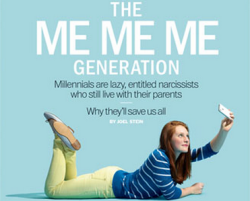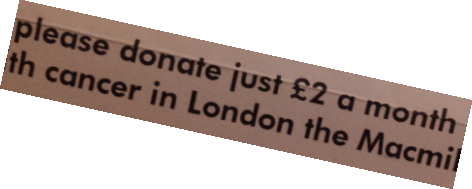Many of you will have seen the amazing story of Darek Fidyka, the Polish man now walking again with a frame after being paralysed in a knife attack in 2010. The words “medical breakthrough” are perhaps overused but the reconstruction of nerve tissues enabling paralysed people to walk certainly warrants them.
What we don’t always see is how the breakthroughs were funded and I wanted to share the examples of the two charities involved in this amazing story by way of an example on how to make the most of success stories. The two charities are UK Stem Cell Foundation (UKSCF) and Nicholls Spinal Injury Foundation (nsif). Read more…
Being selfish is doing good

Social media is self-centred.
Cue riots, reasoned argument and case study evidence to the contrary from those defending social media use. Please hold fire for a second though as I’m not attacking social media (this is a blog after all). I’m thinking about what gets coverage, what fundraising campaigns really take off and why.
This year has seen the phenomenal financial success of the Ice bucket challenge (over $100m!) and the no make-up selfie and they both have two things in common:
- They are incredible social media, sharing phenomena
- They are all about individuals being the centre of attention (the word “selfie” is kind of suggestive here)
According to an interesting blog by Claire Slevin at Like Charity, one of the biggest drivers to social media being used for fundraising is giving avid users something they value highly… content for their Facebook page, Instagram profile or Twitter feed.
This implies that said audience is motivated by shouting about themselves, sharing what they’re doing, putting themselves out there etc etc etc, and loving the fact that charity campaigns give them another excuse to do so. I think there’s something in this point of view; not positive, negative or judgemental but definitely observational.
It makes want to look at exactly how many people who took part in the ice-bucket challenge and plastered themselves all over social media actually donated… of those that I know personally it’s no more than 50%. So what were they doing?
There’s a whole thesis in here on why social media users are motivated to get involved in campaigns and why it’s as popular as it is. I’m certainly not qualified to conclude anything but I suspect that there is a lot more “me, me, me” than altruism within these social media campaigns. When we see more selfless-ies than selfies, maybe things will change. When campaigns that revolve around doing something because it’s the right thing to do, not because we get a moment in the digital spotlight, are as successful as the ice bucket challenge, perhaps I’ll think differently.
But then again, how will I know that it’s happening as it won’t be shared through social media?!?
Ultimately, even the motivation is inherently self-centred, who cares when this much money is being raised to support some outstanding causes? In the short-term I can only see upsides.
In the longer term, I’m not sure what this says about our society and our ability to collectively think beyond next month’s meme. I’m hoping that this perhaps selfish side of our psyche will remain a part of what we are and not become the mainstay the minute Google works out a way of plugging YouTube directly into our minds. But that’s a bit deep and meaningful for a blog.
Did you take part in one of these challenges? And, if you don’t mind sharing, why and did you donate?
Just being transparent isn’t good enough
Sharing what we do with the world will have no positive effect at all if what we’re doing isn’t the right thing in the first place!
Following successive negative media headlines on charity executive pay, regular research suggesting that public trust in charities may be on a downward trajectory and general hand-wringing about what we can do as a result, I want to take issue with those who propose transparency as the answer. Read more…

A few weeks ago, we wrote a blog around how difficult it is to plan and budget for social media fundraising success. We used the example of Teenage Cancer Trust and their megafundraiser Stephen Sutton who sadly died on May 14th.
A follow-up blog was promised but was delayed due to Stephen’s passing; we thought the articles and coverage that week should be about the incredible fundraising achievements. Read more…
Teenage Cancer Trusts‘s number one individual fundraiser right now must be terminally ill Stephen Sutton. I received an email yesterday telling me that he had reached his £1m target and Facebook was abuzz so I duly clicked on his Just Giving page and wow! It was over £3m… how is this possible? Read more…
Cost ratios do not turn me on
Charities are “becoming extraordinarily disconnected from their supporters who do not understand the work they do” said Ian Theodoreson, chair of the Charity Finance Group and chief financial officer of the Church of England, last week. That’s fighting talk, that is.
Controversial the article may be but that doesn’t make it any less relevant (if not totally right IMHO). Read more…
5 Myths of Leadership | LinkedIn http://
5 Myths of Leadership | LinkedIn http://ow.ly/vuUGT Interesting thoughts from Ekaterina Walter. What about leveraging your luck?
BBC Nick Clegg and Nigel Farage in heate
BBC Nick Clegg and Nigel Farage in heated BBC debate over #EU http://ow.ly/vnqTC THis issue genearting lots of views 4 a ‘non-issue’ What do we really think?
2013 Christmas fundraising campaigns… 4. Accurate data still key to driving positive responses
This sounds basic, I know. But to the two charities concerned so far this ‘season’, I am Mr Baughen not Mrs Baughen (we’ve told you often enough). It doesn’t endear me to you if you don’t pay attention. And exactly how many girls called Kevin do you know?
Accurate data usage goes beyond personal addresses and salutations. Many campaigns have a regional trigger embedded in them based on the geography of the recipients to help make the campaigns’ message more relevant and elicit a personal connection.
I understand the logic of this tactic and indeed employed it successfully for years whilst working for a number of organisations myself. But you have to get the assumptions right for the campaign to resonate with the recipients.
A few days ago we mentioned a direct mail pack received from Macmillan and I want to return to it to highlight the fact that the ask was wrapped around tangible evidence of benefits my donation would bring for people living with cancer in London.
I don’t live in London. I live in semi-rural Surrey, outside of the M25. I don’t know if the regionalisation is generic or targeted (I suspect it’s the latter) but why not talk to me about what can be achieved more locally to me?
Why not take advantage of the popularity of the localism movement and bring tangible outcomes to a more local level? It doesn’t have to cost any more to develop the messages and yes, the data briefs for campaigns might be a little more complicated but in return for the increased likelihood of a positive response.
Regional hospice charities often get this right, linking what they do to the lives of local supporters and communities. This example is from St Catherine’s Hospice, an end of life charity working in Surrey and West Sussex.
These are all familiar techniques but the emphasis is on the ‘local’ aspects and things that supporters can do locally to make a difference. I think we could all make our services more relevant to supporters locally IF we get the data right when running large campaigns.
The tried and tested mechanic used to be an odd number of monthly giving points, say £3, £5 and £10 with tangible benefits aligned to each. The lead ask featured on the letter, flyer or envelope would be the middle one. This appeals to human psychology in that ‘baby bear’ way where we don’t feel that we’re being mean but can comfortably acknowledge that we want to give more than the minimum but the maximum might be a bit much.
The ‘lead’ ask in at least three of the campaigns we’ve received is right at the bottom – £2 per month. I know times are tough and that there are several fundraising agencies out there encouraging charities to drop the ask levels to boost response rates but I can’t help but wonder what the success rates are.
Anyone happy to share their experience or thoughts to add to the discussion? I know that different charities will target slightly different audiences and consequently the experiences and results will vary but… if the recipient says ‘no’ to £2, where do we go from there?
One answer might be telephone follow up but for £2 a month the payback period could be unacceptable.


